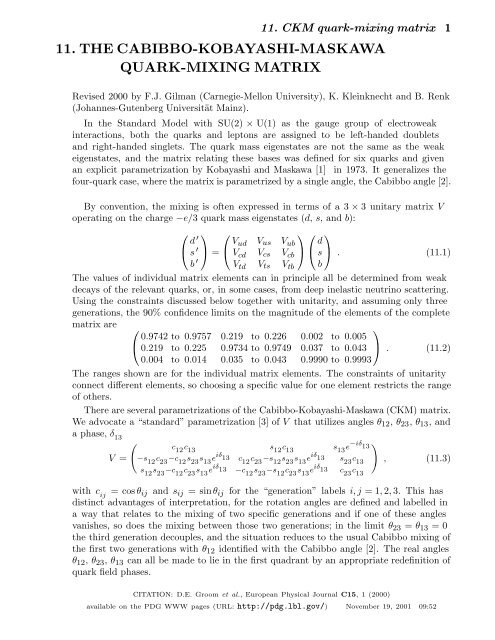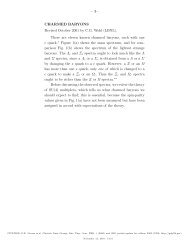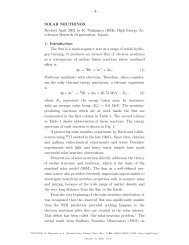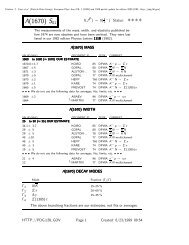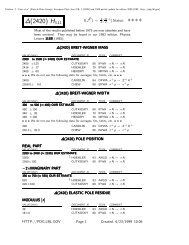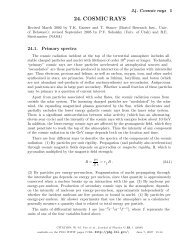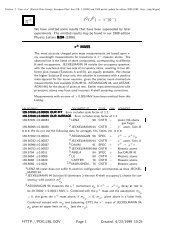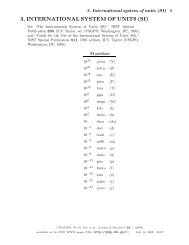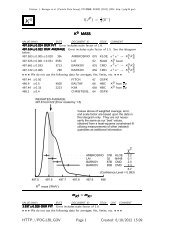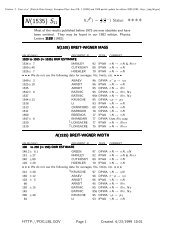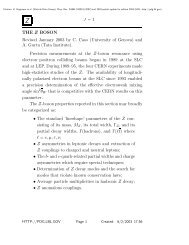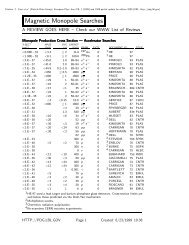11. THE CABIBBO-KOBAYASHI-MASKAWA QUARK-MIXING MATRIX
11. THE CABIBBO-KOBAYASHI-MASKAWA QUARK-MIXING MATRIX
11. THE CABIBBO-KOBAYASHI-MASKAWA QUARK-MIXING MATRIX
Create successful ePaper yourself
Turn your PDF publications into a flip-book with our unique Google optimized e-Paper software.
<strong>11.</strong> CKM quark-mixing matrix 1<br />
<strong>11.</strong> <strong>THE</strong> <strong>CABIBBO</strong>-<strong>KOBAYASHI</strong>-<strong>MASKAWA</strong><br />
<strong>QUARK</strong>-<strong>MIXING</strong> <strong>MATRIX</strong><br />
Revised 2000 by F.J. Gilman (Carnegie-Mellon University), K. Kleinknecht and B. Renk<br />
(Johannes-Gutenberg Universität Mainz).<br />
In the Standard Model with SU(2) × U(1) as the gauge group of electroweak<br />
interactions, both the quarks and leptons are assigned to be left-handed doublets<br />
and right-handed singlets. The quark mass eigenstates are not the same as the weak<br />
eigenstates, and the matrix relating these bases was defined for six quarks and given<br />
an explicit parametrization by Kobayashi and Maskawa [1] in 1973. It generalizes the<br />
four-quark case, where the matrix is parametrized by a single angle, the Cabibbo angle [2].<br />
By convention, the mixing is often expressed in terms of a 3 × 3 unitary matrix V<br />
operating on the charge −e/3 quark mass eigenstates (d, s, andb):<br />
⎛<br />
d ′<br />
⎝ s ′<br />
b ′<br />
⎞ ⎛<br />
⎠ = ⎝ V ⎞ ⎛<br />
ud Vus Vub Vcd Vcs V ⎠ ⎝<br />
cb<br />
Vtd Vts Vtb d<br />
⎞<br />
s ⎠ . (<strong>11.</strong>1)<br />
b<br />
The values of individual matrix elements can in principle all be determined from weak<br />
decays of the relevant quarks, or, in some cases, from deep inelastic neutrino scattering.<br />
Using the constraints discussed below together with unitarity, and assuming only three<br />
generations, the 90% confidence limits on the magnitude of the elements of the complete<br />
matrix are<br />
⎛<br />
⎞<br />
0.9742 to 0.9757 0.219 to 0.226 0.002 to 0.005<br />
⎝ 0.219 to 0.225 0.9734 to 0.9749 0.037 to 0.043 ⎠ . (<strong>11.</strong>2)<br />
0.004 to 0.014 0.035 to 0.043 0.9990 to 0.9993<br />
The ranges shown are for the individual matrix elements. The constraints of unitarity<br />
connect different elements, so choosing a specific value for one element restricts the range<br />
of others.<br />
There are several parametrizations of the Cabibbo-Kobayashi-Maskawa (CKM) matrix.<br />
We advocate a “standard” parametrization [3] of V that utilizes angles θ12, θ23, θ13, and<br />
a phase, δ13 <br />
c12 c13 s12c13 s13e V =<br />
−iδ 13<br />
, (<strong>11.</strong>3)<br />
−s 12 c 23 −c 12 s 23 s 13 e iδ 13 c 12 c 23 −s 12 s 23 s 13 e iδ 13 s 23 c 13<br />
s 12 s 23 −c 12 c 23 s 13 e iδ 13 −c 12 s 23 −s 12 c 23 s 13 e iδ 13 c 23 c 13<br />
with c ij =cosθij and sij =sinθij for the “generation” labels i, j =1,2,3. This has<br />
distinct advantages of interpretation, for the rotation angles are defined and labelled in<br />
a way that relates to the mixing of two specific generations and if one of these angles<br />
vanishes, so does the mixing between those two generations; in the limit θ23 = θ13 =0<br />
the third generation decouples, and the situation reduces to the usual Cabibbo mixing of<br />
the first two generations with θ12 identified with the Cabibbo angle [2]. The real angles<br />
θ12, θ23, θ13 can all be made to lie in the first quadrant by an appropriate redefinition of<br />
quark field phases.<br />
CITATION: D.E. Groom et al., European Physical Journal C15, 1 (2000)<br />
available on the PDG WWW pages (URL: http://pdg.lbl.gov/) November 19, 2001 09:52
2 <strong>11.</strong> CKM quark-mixing matrix<br />
The matrix elements in the first row and third column, which can be directly measured<br />
in decay processes, are all of a simple form, and, as c 13 is known to deviate from unity<br />
only in the sixth decimal place, V ud = c 12 , Vus = s 12 , Vub = s 13 e −iδ 13 , Vcb = s 23 ,and<br />
V tb = c 23 to an excellent approximation. The phase δ 13 lies in the range 0 ≤ δ 13 < 2π,<br />
with nonzero values generally breaking CP invariance for the weak interactions. The<br />
generalization to the n generation case contains n(n − 1)/2 angles and (n − 1)(n − 2)/2<br />
phases. The range of matrix elements in Eq. (<strong>11.</strong>2) corresponds to 90% CL limits on the<br />
sines of the angles of s 12 =0.219 to 0.226,s 23 =0.037 to 0.043, and s 13 =0.002 to 0.005.<br />
Kobayashi and Maskawa [1] originally chose a parametrization involving the four angles<br />
θ1, θ2, θ3, andδ:<br />
<br />
d ′<br />
s ′<br />
<br />
c1<br />
=<br />
b ′<br />
−s<br />
1<br />
c<br />
3<br />
−s<br />
1<br />
s<br />
3<br />
s1c2 c1c2c3−s2s3eiδ c1 c2 s3 +s2c3 eiδ s 1 s 2 c 1 s 2 c 3 +c 2 s 3 e iδ c 1 s 2 s 3 −c 2 c 3 e iδ<br />
<br />
d<br />
s , (<strong>11.</strong>4)<br />
where ci =cosθiand si =sinθifor i =1,2,3. In the limit θ2 = θ3 = 0, this reduces to<br />
the usual Cabibbo mixing with θ1 identified (up to a sign) with the Cabibbo angle [2].<br />
Several different forms of the Kobayashi-Maskawa parametrization are found in the<br />
literature. Since all these parametrizations are referred to as “the” Kobayashi-Maskawa<br />
form, some care about which one is being used is needed when the quadrant in which δ<br />
lies is under discussion.<br />
A popular approximation that emphasizes the hierarchy in the size of the angles,<br />
s12 ≫ s23 ≫ s13 , is due to Wolfenstein [4], where one sets λ ≡ s12 , the sine of the<br />
Cabibbo angle, and then writes the other elements in terms of powers of λ:<br />
V ≈<br />
⎛<br />
⎝ 1 − λ2 /2 λ Aλ 3 (ρ−iη)<br />
−λ 1 − λ 2 /2 Aλ 2<br />
Aλ 3 (1 − ρ − iη) −Aλ 2 1<br />
b<br />
⎞<br />
⎠ . (<strong>11.</strong>5)<br />
with A, ρ, andηreal numbers that were intended to be of order unity.<br />
More recently, another parametrization has been advocated [5]. It arises in many<br />
theories of quark masses and is particularly useful where one builds models in which<br />
initially mu = md = 0 and there is no nontrivial phase in the CKM matrix. In this<br />
parametrization [5] no phases occur in the third row or third column of the CKM matrix,<br />
so that the CP-violating phase only occurs in the CKM matrix elements connecting first<br />
and second generation quarks. Consequently, the connection between measurements of<br />
CP-violating effects for B mesons and single CKM parameters is less obvious than in the<br />
standard parametrization.<br />
No physics can depend on which of the above parametrizations (or any other) is used,<br />
as long as a single one is used consistently and care is taken to be sure that no other<br />
choice of phases is in conflict.<br />
Our present knowledge of the matrix elements comes from the following sources:<br />
November 19, 2001 09:52
<strong>11.</strong> CKM quark-mixing matrix 3<br />
(1)|Vud|: Analyses have been performed comparing nuclear beta decays that proceed<br />
through a vector current to muon decay. Radiative corrections are essential to extracting<br />
the value of the matrix element. They already include [6] effects of order Zα 2 ,andmost<br />
of the theoretical argument centers on the nuclear mismatch and structure-dependent<br />
radiative corrections [7,8]. New data have been obtained on superallowed 0 + → 0 + beta<br />
decays [9].<br />
Taking the complete data set, a value of |Vud| =0.9740 ± 0.0005 has been obtained [10].<br />
It has been argued [11] that the change in charge-symmetry-violation for quarks inside<br />
nucleons that are in nuclear matter results in an additional change in the predicted decay<br />
rate by 0.075 to 0.2%, leading to a systematic underestimate of |Vud|. This reasoning<br />
has been used [12] to explain quantitatively the binding energy differences of the valence<br />
protons and neutrons of mirror nuclei. While it can be argued [10] that there may<br />
be double-counting of corrections, until this is settled, we take this correction as an<br />
additional uncertainty to obtain a value of |Vud| =0.9740 ± 0.0010 .<br />
The theoretical uncertainties in extracting a value of |Vud| from neutron decays are<br />
significantly smaller than for decays of mirror nuclei, but the value depends on both<br />
the value of gA/gV and the neutron lifetime. Experimental progress has been made on<br />
the former quantity using very highly polarized cold neutrons together with improved<br />
detectors. Averaging over recent experiments [13] gives gA/gV = −1.2715 ± 0.0021 and<br />
results in |Vud| =0.9728 ± 0.0012 from neutron decay. Since most of the contributions<br />
to the errors in these two determinations of |Vud| are independent, we average them to<br />
obtain<br />
|Vud| =0.9735 ± 0.0008 . (<strong>11.</strong>6)<br />
(2)|Vus|: Analysis of Ke3decays yields [14]<br />
|Vus| =0.2196 ± 0.0023 . (<strong>11.</strong>7)<br />
With isospin violation taken into account in K + and K0 decays, the extracted values of<br />
|Vus| are in agreement at the 1% level. A reanalysis [8] obtains essentially the same value,<br />
but quotes a somewhat smaller error, which is only statistical. The analysis [15] of hyperon<br />
decay data has larger theoretical uncertainties because of first order SU(3) symmetry<br />
breaking effects in the axial-vector couplings. This has been redone incorporating second<br />
order SU(3) symmetry breaking corrections in models [16] applied to the WA2 data [17]<br />
to give a value of |Vus| =0.2176 ± 0.0026, which is consistent with Eq. (<strong>11.</strong>7) using the<br />
“best-fit” model. Since the values obtained in the models differ outside the errors and<br />
generally do not give good fits, we retain the value in Eq. (<strong>11.</strong>7) for |Vus|.<br />
(3)|Vcd|: The magnitude of |Vcd| may be deduced from neutrino and antineutrino<br />
production of charm off valence d quarks. The dimuon production cross sections of the<br />
CDHS group [18] yield Bc |Vcd| 2 =0.41 ± 0.07 × 10−2 ,whereBcis the semileptonic<br />
branching fraction of the charmed hadrons produced. The corresponding value from the<br />
more recent CCFR Tevatron experiment [19], where a next-to-leading-order QCD analysis<br />
has been carried out, is 0.534 ± 0.021 +0.025<br />
−0.051 × 10−2 , where the last error is from the scale<br />
uncertainty. Assuming a similar scale error for the CDHS result and averaging these two<br />
November 19, 2001 09:52
4 <strong>11.</strong> CKM quark-mixing matrix<br />
results gives 0.49 ± 0.05 × 10 −2 . Supplementing this with data [20] on the mix of charmed<br />
particle species produced by neutrinos and PDG values for their semileptonic branching<br />
fractions (to give [19] Bc =0.099 ± 0.012) then yields<br />
|Vcd| =0.224 ± 0.016 . (<strong>11.</strong>8)<br />
(4)|Vcs|: Values of |Vcs| from neutrino production of charm are dependent on assumptions<br />
about the strange-quark density in the parton sea. The most conservative assumption,<br />
that the strange-quark sea does not exceed the value corresponding to an SU(3)symmetric<br />
sea, leads to a lower bound [18], |Vcs| > 0.59. It is more advantageous to<br />
proceed analogously to the method used for extracting |Vus| from Ke3 decay; namely, we<br />
compare the experimental value for the width of De3 decay with the expression [21] that<br />
follows from the standard weak interaction amplitude:<br />
Γ(D → Ke + νe) =|f D + (0)|2 |Vcs| 2 (1.54 × 10 11 s −1 ) . (<strong>11.</strong>9)<br />
Here f D + (q2 ), with q = pD − pK , is the form factor relevant to De3 decay; its variation<br />
has been taken into account with the parametrization f D + (t)/fD + (0) = M2 /(M 2 − t) and<br />
M=2.1GeV/c 2 , a form and mass consistent with direct measurements [22]. Combining<br />
data on branching fractions for De3 decays with accurate values for the D lifetimes [22]<br />
yields a value of (0.818 ± 0.041) × 10 11 s −1 for Γ(D → Ke + νe). Therefore<br />
|f D + (0)|2 |Vcs| 2 =0.531 ± 0.027 . (<strong>11.</strong>10)<br />
A very conservative assumption is that |fD + (0)| < 1, from which it follows that<br />
|Vcs| > 0.62. Calculations of the form factor either performed [23,24] directly at q2 =0,<br />
or done [25] at the maximum value of q2 =(mD−mK) 2 and interpreted at q2 =0using<br />
the measured q2 dependence, give the value fD + (0) = 0.7 ± 0.1. It follows that<br />
|Vcs| =1.04 ± 0.16 . (<strong>11.</strong>11)<br />
Recent measurements [26] of |Vcs| in charmed-tagged W decays give a consistent result of<br />
|Vcs| =0.97 ± 0.09 (stat.) ± 0.07 (syst.). The constraint of unitarity when there are only<br />
three generations gives a much tighter bound (see below).<br />
(5)|Vcb|: The heavy quark effective theory [27] (HQET) provides a nearly modelindependent<br />
treatment of B semileptonic decays to charmed mesons, assuming that both<br />
the b and c quarks are heavy enough for the theory to apply. Measurements of the<br />
exclusive decay B → D ∗ ℓ + ν ℓ have been used primarily to extract a value of |V cb| using<br />
corrections based on the HQET. Exclusive B → Dℓ + ν ℓ decays give a consistent but less<br />
precise result. Analysis of inclusive decays, where the measured semileptonic bottom<br />
hadron partial width is assumed to be that of a b quark decaying through the usual V –A<br />
interaction, depends on going from the quark to the hadron level. This is also understood<br />
within the context of the HQET [28], and the results for |V cb| are again consistent with<br />
November 19, 2001 09:52
<strong>11.</strong> CKM quark-mixing matrix 5<br />
those from exclusive decays. Combining all the LEP data on both exclusive and inclusive<br />
decays gives [29]<br />
|V cb| =0.0402 ± 0.0019 , (<strong>11.</strong>12)<br />
which is consistent with the latest CLEO result [29] from exclusive and inclusive decays,<br />
|Vcb| =0.0404 ± 0.0034. The combination of large data samples and the HQET make this<br />
the third most accurately measured CKM matrix element, after |Vud| and |Vus|.<br />
(6)|Vub|: The decay b → uℓν and its charge conjugate can be observed from the<br />
semileptonic decay of B mesons produced on the Υ (4S) (bb) resonance by measuring<br />
the lepton energy spectrum above the endpoint of the b → cℓνℓ spectrum. There the<br />
b → uℓνℓ decay rate can be obtained by subtracting the background from nonresonant<br />
e + e− reactions. This continuum background is determined from auxiliary measurements<br />
off the Υ (4S). The interpretation of the result in terms of |Vub/Vcb| depends fairly<br />
strongly on the theoretical model used to generate the lepton energy spectrum, especially<br />
for b → u transitions [24,25,30].<br />
The LEP experiments ALEPH [31], L3 [32], and DELPHI [33] have presented new<br />
analyses that measure the b → uℓνℓ component in b decays at the Z0 . Discrimination<br />
between u-like and c-like decays is based on up to 20 different event parameters which<br />
are sensitive to the mass of the quark of the final state. Using an extended range of the<br />
spectrum compared to the end-point analysis, this extraction of |Vub| is less sensitive to<br />
theoretical assumptions, but requires a detailed understanding of the decay b → cℓνℓ. The value of |Vub| can also be extracted from exclusive decays, such as B → πℓνℓ and B → ρℓνℓ, but there is an associated theoretical model dependence in the values<br />
of the matrix elements of the weak current between exclusive states. There has been a<br />
substantial increase in the data from CLEO for these exclusive decays [29], and the error<br />
on |Vub|, arising primarily from the theoretical model dependence, is comparable to that<br />
obtained from inclusive decays. Enhanced awareness of the theoretical uncertainties and<br />
the difference between the results obtained from inclusive and exclusive analyses leads us<br />
to be even more conservative in setting the error bar than in previous reviews and we<br />
quote [34]<br />
|Vub/Vcb| =0.090 ± 0.025 . (<strong>11.</strong>13)<br />
(7)Vtb: The discovery of the top quark by the CDF and DØ collaborations utilized in<br />
part the semileptonic decays of t to b. One can set a (still rather crude) limit on the<br />
fraction of decays of the form t → bℓ + ν ℓ, as opposed to semileptonic t decays that<br />
involve s or d quarks, of [35]<br />
|Vtb| 2<br />
|Vtd| 2 + |Vts| 2 =0.99 ± 0.29 . (<strong>11.</strong>14)<br />
+ |V 2<br />
tb|<br />
(8)Hadronic W decays: The ratio of hadronic W decays to leptonic decays has been<br />
measured at LEP, with the result [36] that Σi,j|Vij| 2 =2.032 ± 0.032, where the sum<br />
extends over i = u, c and j = d, s, b. With a three-generation CKM matrix, from unitarity<br />
this sum would be expected to have the value 2. Since five of the CKM matrix elements<br />
November 19, 2001 09:52
6 <strong>11.</strong> CKM quark-mixing matrix<br />
are well measured or contribute negligibly to the sum of the squares, this measurement<br />
can also be used as a precision measurement of |Vcs| =0.9891 ± 0.016.<br />
For most of these CKM matrix elements the principal error is no longer experimental,<br />
but rather theoretical. This arises from explicit model dependence in interpreting data<br />
or in the use of specific hadronic matrix elements to relate experimental measurements<br />
to weak transitions of quarks. This type of uncertainty arises even more strongly in<br />
extracting CKM matrix elements from loop diagrams, as discussed below. Such errors<br />
are not distributed in a Gaussian manner. We have taken the interpretation that a “1 σ”<br />
range in a theoretical error corresponds to a 68% likelihood that the true value lies within<br />
“±1 σ” of the central value. While we do use the central values with the quoted errors to<br />
make a best overall fit to the CKM matrix, the result should be taken with appropriate<br />
care, and we regard extending this to multi-standard-deviation determinations of allowed<br />
regions for CKM matrix elements as unfounded.<br />
The results for three generations of quarks, from Eqs. (<strong>11.</strong>6)–(<strong>11.</strong>8) and Eqs. (<strong>11.</strong>11)–<br />
(<strong>11.</strong>14), plus unitarity, are summarized in the matrix in Eq. (<strong>11.</strong>2). The ranges given<br />
there are different from those given in Eqs. (<strong>11.</strong>6)–(<strong>11.</strong>14) because of the inclusion of<br />
unitarity, but are consistent with the one-standard-deviation errors on the input matrix<br />
elements. Note in particular that the unitarity constraint has pushed |V ud| about one<br />
standard deviation higher than given in Eq. (<strong>11.</strong>6). If we had kept the error on |V ud|<br />
quoted by Hardy and Towner [10], we would have a violation of unitarity in the first row<br />
of the CKM matrix by about two standard deviations. While this bears watching and<br />
encourages another more accurate measurement of |Vus|, we do not see this presently as a<br />
major challenge to the validity of the three-generation Standard Model.<br />
The data do not preclude there being more than three generations. Moreover, the<br />
entries deduced from unitarity might be altered when the CKM matrix is expanded to<br />
accommodate more generations. Conversely, the known entries restrict the possible values<br />
of additional elements if the matrix is expanded to account for additional generations.<br />
For example, unitarity and the known elements of the first row require that any additional<br />
element in the first row have a magnitude |Vub ′| < 0.10. When there are more than three<br />
generations, the allowed ranges (at 90% CL) of the matrix elements connecting the first<br />
three generations are<br />
⎛<br />
⎞<br />
0.9722 to 0.9748 0.216 to 0.223 0.002 to 0.005 ...<br />
⎜ 0.209 to 0.228 0.959 to 0.976 0.037 to 0.043 ... ⎟<br />
⎜<br />
⎟<br />
⎝ 0 to 0.09 0 to 0.16 0.07 to 0.993 ... ⎠<br />
, (<strong>11.</strong>15)<br />
.<br />
.<br />
.<br />
where we have used unitarity (or the expanded matrix) and the measurements of the<br />
magnitudes of the CKM matrix elements (including the constraint from hadronic W<br />
decays), resulting in the weak bound |Vtb| > 0.07.<br />
Further information, particularly on CKM matrix elements involving the top quark, can<br />
be obtained from flavor-changing processes that occur at the one-loop level. We have not<br />
used this information in the discussion above since the derivation of values for Vtd and Vts<br />
in this manner from, for example, B mixing or b → sγ, require an additional assumption<br />
November 19, 2001 09:52
<strong>11.</strong> CKM quark-mixing matrix 7<br />
that the top-quark loop, rather than new physics, gives the dominant contribution to the<br />
process in question. Conversely, the agreement of CKM matrix elements extracted from<br />
loop diagrams with the values based on direct measurements and three generations can<br />
be used to place restrictions on new physics.<br />
The measured value [37] of ∆M Bd =0.473 ± 0.016 ps −1 from B 0 d<br />
− B0<br />
d mixing<br />
canbeturnedinthiswayintoinformationon|V tb ∗ Vtd|, assuming that the dominant<br />
contribution to the mass difference arises from the matrix element between a B d and<br />
a Bd of an operator that corresponds to a box diagram with W bosons and top<br />
quarks as sides. Using the characteristic hadronic matrix element that then occurs,<br />
B Bdf 2<br />
Bd = (210 ± 40 MeV) 2 from lattice QCD calculations [38], which we regard as<br />
having become the most reliable source of such matrix elements, next-to-leading-order<br />
QCD corrections (ηQCD =0.55) [39], and the running top-quark mass, mt(mt) = 166 ± 5<br />
GeV, as input,<br />
∗<br />
|Vtb · Vtd| =0.0083 ± 0.0016 , (<strong>11.</strong>16)<br />
where the uncertainty comes primarily from that in the hadronic matrix elements, whose<br />
estimated errors are combined linearly.<br />
In the ratio of Bs to Bd mass differences, many common factors (such as the QCD<br />
correction and dependence on the top-quark mass) cancel, and we have<br />
∆M Bs<br />
∆M Bd<br />
= MBs<br />
M Bd<br />
B Bs f 2 Bs<br />
BB d f 2 B d<br />
|V ∗<br />
tb · Vts|<br />
2<br />
|V ∗<br />
tb · Vtd| 2 . (<strong>11.</strong>17)<br />
With the experimentally measured masses [22], BBs / BB d =(1.14 ± 0.13) 2 with quite<br />
conservative error bars from lattice QCD [38], and the improved experimental lower<br />
limit [37] at 95% CL of ∆M Bs > 14.3 ps−1 ,<br />
|Vtd|/|Vts| < 0.24 (<strong>11.</strong>18)<br />
Since with three generations, |Vts| ≈|Vcb|, this result converts to |Vtd| < 0.010, which is a<br />
significant constraint by itself (see Fig. <strong>11.</strong>2).<br />
The CLEO observation [40] of b → sγ can be translated [41] similarly into<br />
|Vts|/|V cb| =1.1±0.43, where the large uncertainty is again dominantly theoretical. In<br />
K + → π + νν there are significant contributions from loop diagrams involving both charm<br />
and top quarks. Experiment is just beginning to probe the level predicted in the Standard<br />
Model [42].<br />
All these additional indirect constraints are consistent with the matrix elements<br />
obtained from the direct measurements plus unitarity, assuming three generations; with<br />
the recent results on B mixing and theoretical improvements in lattice calculations,<br />
adding the indirect constraints to the fit reduces the range allowed for |Vtd|. Direct and indirect information on the CKM matrix is neatly summarized in terms<br />
of “the unitarity triangle,” one of six such triangles that correspond to the unitarity<br />
November 19, 2001 09:52
8 <strong>11.</strong> CKM quark-mixing matrix<br />
condition applied to two different rows or columns of the CKM matrix. Unitarity of the<br />
3 × 3 CKM matrix applied to the first and third columns yields<br />
Vud V ∗ ub + Vcd V ∗<br />
cb + VtdV ∗<br />
tb =0. (<strong>11.</strong>19)<br />
The unitarity triangle is just a geometrical presentation of this equation in the complex<br />
plane [43]. We can always choose to orient the triangle so that V cd Vcb ∗ lies along the<br />
horizontal; in the parametrization we have chosen, V cb is real, and V cd isrealtoavery<br />
good approximation in any case. Setting cosines of small angles to unity, Eq. (<strong>11.</strong>19)<br />
becomes<br />
V ub ∗ + Vtd = s12 V cb ∗ , (<strong>11.</strong>20)<br />
which is shown as the unitarity triangle in Fig. <strong>11.</strong>1(a). Rescaling the triangle by a factor<br />
[1/|s12 V cb|] so that the base is of unit length, the coordinates of the vertices become<br />
A Re(V ub)/|s12 V cb| , − Im(V ub)/|s12 V cb| , B(1, 0) , C(0, 0) . (<strong>11.</strong>21)<br />
In the Wolfenstein parametrization [4], the coordinates of the vertex A of the unitarity<br />
triangle are simply (ρ, η), as shown in Fig. <strong>11.</strong>1(b). The angle γ = δ13.<br />
(a)<br />
C<br />
(b)<br />
V * ub<br />
γ<br />
γ<br />
C = (0,0)<br />
α<br />
A<br />
s 12 V cb *<br />
α<br />
A = (ρ,η)<br />
V td<br />
β<br />
β<br />
B<br />
B = (1,0)<br />
Figure <strong>11.</strong>1: (a) Representation in the complex plane of the triangle formed by the<br />
CKM matrix elements V ub ∗ , Vtd, ands12 V cb ∗ . (b) Rescaled triangle with vertices<br />
A(ρ, η), B(1, 0), and C(0, 0).<br />
November 19, 2001 09:52
<strong>11.</strong> CKM quark-mixing matrix 9<br />
CP-violating processes will involve the phase in the CKM matrix, assuming that<br />
the observed CP violation is solely related to a nonzero value of this phase. This<br />
allows additional constraints to be brought to bear. More specifically, a necessary and<br />
sufficient condition for CP violation with three generations can be formulated in a<br />
parametrization-independent manner in terms of the nonvanishing of the determinant of<br />
the commutator of the mass matrices for the charge 2e/3 and charge −e/3 quarks [44].<br />
CP-violating amplitudes or differences of rates are all proportional to the CKM factor in<br />
this quantity. This is the product of factors s12s13s23c12c2 13 c23sδ in the parametrization<br />
13<br />
adopted above, and is s2 1 s2s3 c1c2 c3s in that of Ref. 1. With the approximation of<br />
δ<br />
setting cosines to unity, this is just twice the area of the unitarity triangle.<br />
While hadronic matrix elements whose values are imprecisely known generally enter<br />
the calculations, the constraints from CP violation in the neutral kaon system, taken<br />
together with the restrictions on the magnitudes of the CKM matrix elements shown<br />
above, are tight enough to restrict considerably the range of angles and the phase of the<br />
CKM matrix. For example, the constraint obtained from the CP-violating parameter ɛ<br />
in the neutral K system corresponds to the vertex A of the unitarity triangle lying on a<br />
hyperbola for fixed values of the hadronic matrix elements [45,46]. In addition, following<br />
the initial evidence [47], it is now established that direct CP violation in the weak<br />
transition from a neutral K to two pions exists, i.e., that the parameter ɛ ′ is nonzero [48].<br />
However, theoretical uncertainties in hadronic matrix elements of cancelling amplitudes<br />
presently preclude this measurement from giving a significant constraint on the unitarity<br />
triangle.<br />
The constraints on the vertex of the unitarity triangle that follow from |V ub|, B mixing,<br />
and ɛ are shown in Fig. <strong>11.</strong>2. The improved limit in Eq. (<strong>11.</strong>18) that arises from the<br />
ratio of Bs to B d mixing eliminates a significant region for the vertex A of the unitarity<br />
triangle, a region otherwise allowed by direct measurements of the CKM matrix elements,<br />
essentially limiting the vertex A to be in the first quadrant (ρ positive). The limit is not<br />
far from the value we would expect from the other information on the unitarity triangle.<br />
Thus a significant increase in experimental sensitivity to Bs mixing will lead either to an<br />
observation of mixing or an indication of physics beyond the Standard Model. This limit<br />
is more robust theoretically since it depends on ratios (rather than absolute values) of<br />
hadronic matrix elements and is independent of the top mass or QCD corrections (which<br />
cancel in the ratio).<br />
Ultimately in the Standard Model, the CP-violating process K L → π 0 νν offers high<br />
precision in measuring the imaginary part of V td · Vts ∗ ,which,givenVts, will yield the<br />
altitude of the unitarity triangle. However, the experimental upper limit is presently<br />
many orders of magnitude away from the requisite sensitivity.<br />
For CP-violating asymmetries of neutral B mesons decaying to CP eigenstates, for<br />
certain final states arising from a single weak decay amplitude there is a direct relationship<br />
between the magnitude of the asymmetry in a given decay and sin 2φ, whereφ=α,β,<br />
γis an appropriate angle of the unitarity triangle [43]. The CDF Collaboration has used<br />
the decay B d(B d) → ψKS to obtain a first indication [49] of a nonvanishing asymmetry,<br />
November 19, 2001 09:52
,,,,<br />
10 <strong>11.</strong> CKM quark-mixing matrix<br />
,,,,<br />
ΔM<br />
0.006<br />
Bd<br />
,,,,<br />
0.004<br />
_____ ΔMBs<br />
ΔMBs<br />
,,,,<br />
A<br />
ΔMBd<br />
ΔMBd<br />
0.002<br />
V ub<br />
0.000<br />
C<br />
B<br />
,,,,<br />
–0.004 –0.002 0.000 0.002 0.004 0.006 0.008 0.010<br />
|s 12V cb|<br />
Figure <strong>11.</strong>2: Constraints on the position of the vertex, A, of the unitarity triangle<br />
following from |V ub|, B mixing, and the CP-violating parameter ɛ. A possible<br />
unitarity triangle is shown with A in the preferred region.<br />
corresponding to a value of sin 2β:<br />
sin 2β =0.79 +0.41<br />
−0.44<br />
. (<strong>11.</strong>22)<br />
This is consistent with the other information in Fig. <strong>11.</strong>2 including having the correct<br />
sign, which is positive at the 93% CL. It presages the data that will be obtained in<br />
the next several years on both the magnitudes and relative phases of the CKM matrix<br />
elements, permitting incisive tests of this part of the Standard Model. (See Sec. 12 on CP<br />
Violation and the review on “CP Violation in B decay—Standard Model Predictions” in<br />
the B Listings.)<br />
References:<br />
1. M. Kobayashi and T. Maskawa, Prog. Theor. Phys. 49, 652 (1973).<br />
2. N. Cabibbo, Phys. Rev. Lett. 10, 531 (1963).<br />
3. L.-L. Chau and W.-Y. Keung, Phys. Rev. Lett. 53, 1802 (1984);<br />
H. Harari and M. Leurer, Phys. Lett. B181, 123 (1986);<br />
H. Fritzsch and J. Plankl, Phys. Rev. D35, 1732 (1987);<br />
F.J. Botella and L.-L. Chao, Phys. Lett. B168, 97 (1986).<br />
4. L. Wolfenstein, Phys. Rev. Lett. 51, 1945 (1983).<br />
5. C.D. Froggatt and H.B. Nielsen, Nucl. Phys. B147, 277 (1979);<br />
H. Fritzsch, Nucl. Phys. B155, 189 (1979);<br />
S.Dimopoulos,L.J.Hall,andS.Raby,Phys.Rev.Lett.68, 1984 (1992);<br />
H. Fritzsch and Z.-Z. Xing, Phys. Lett. B413, 396 (1997).<br />
6. W.J. Marciano and A. Sirlin, Phys. Rev. Lett. 56, 22 (1986);<br />
A. Sirlin and R. Zucchini, Phys. Rev. Lett. 57, 1994 (1986);<br />
November 19, 2001 09:52
<strong>11.</strong> CKM quark-mixing matrix 11<br />
W. Jaus and G. Rasche, Phys. Rev. D35, 3420 (1987);<br />
A. Sirlin, Phys. Rev. D35, 3423 (1987).<br />
7. B.A. Brown and W.E. Ormand, Phys. Rev. Lett. 62, 866 (1989).<br />
8. F.C. Barker et al., Nucl.Phys.A540, 501 (1992);<br />
F.C. Barker et al., Nucl.Phys.A579, 62 (1994).<br />
9. G. Savard et al., Phys. Rev. Lett. 74, 1521 (1995).<br />
10. J.C. Hardy and I.S. Towner, talk at WEIN98 (Santa Fe, June 14–21, 1998) and<br />
nucl-th/9809087.<br />
<strong>11.</strong> K.P. Saito and A.W. Thomas, Phys. Lett. B363, 157 (1995).<br />
12. K. Tsushima, K. Saito, and A.W. Thomas, nucl-th/9907101.<br />
13. H. Abele et al., Phys. Lett. B407, 212 (1997);<br />
J. Reich et al., ILL Workshop, October 1998;<br />
E. Bopp et al., Phys. Rev. Lett. 56, 919 (1986);<br />
P. Liaud, Nucl. Phys. A612, 53 (1997).<br />
14. H. Leutwyler and M. Roos, Z. Phys. C25, 91 (1984). See also the work of R.E.<br />
Shrock and L.-L. Wang, Phys. Rev. Lett. 41, 1692 (1978).<br />
15. J.F. Donoghue, B.R. Holstein, and S.W. Klimt, Phys. Rev. D35, 934 (1987).<br />
16. R. Flores-Mendieta, A. García, and G. Sánchez-Colón, Phys. Rev. D54, 6855 (1996).<br />
17. M. Bourquin et al., Z.Phys.C21, 27 (1983).<br />
18. H. Abramowicz et al., Z.Phys.C15, 19 (1982).<br />
19. S.A. Rabinowitz et al., Phys. Rev. Lett. 70, 134 (1993);<br />
A.O. Bazarko et al., Z.Phys.C65, 189 (1995).<br />
20. N. Ushida et al., Phys. Lett. B206, 375 (1988).<br />
21. F. Bletzacker, H.T. Nieh, and A. Soni, Phys. Rev. D16, 731 (1977).<br />
22. C. Caso et al., Review of Particle Physics, Eur. Phys. J. C3, 1 (1998).<br />
23. T.M. Aliev et al., Yad. Fiz. 40, 823 (1984) [Sov. J. Nucl. Phys. 40, 527 (1984)].<br />
24. M. Bauer, B. Stech, and M. Wirbel, Z. Phys. C29, 637 (1985).<br />
25. B. Grinstein, N. Isgur, and M.B. Wise, Phys. Rev. Lett. 56, 298 (1986);<br />
B. Grinstein et al., Phys.Rev.D39, 799 (1989).<br />
26. P. Abreu et al., Phys. Lett. B439, 209 (1998);<br />
R. Barate et al., Phys. Lett. B465, 349 (1999).<br />
27. N. Isgur and M.B. Wise, Phys. Lett. B232, 113 (1989) and Phys. Lett. B237, 527<br />
(1990);<br />
E.E. Eichten and B. Hill, Phys. Lett. B234, 511 (1990);<br />
M.E. Luke, Phys. Lett. B252, 447 (1990).<br />
28. M. Neubert, to appear in Heavy Flavors, Second Edition, edited by A.J. Buras and<br />
M. Lindner (World Scientific, Singapore, 1997), p. 239.<br />
November 19, 2001 09:52
12 <strong>11.</strong> CKM quark-mixing matrix<br />
29. R. Poling, plenary talk at the XIX International Symposium on Lepton and Photon<br />
Interactions at High Energies (Stanford, August 9–14, 1999).<br />
30. G. Altarelli et al., Nucl.Phys.B208, 365 (1982).<br />
31. R. Barate et al., Eur.Phys.J.C6, 555 (1999).<br />
32. M. Acciarri et al., Phys. Lett. B436, 174 (1998).<br />
33. P. Abreu et al., Phys. Lett. B478, 14 (2000).<br />
34. A. Falk, plenary talk at the XIX International Symposium on Lepton and Photon<br />
Interactions at High Energies (Stanford, August 9–14, 1999);<br />
Z. Ligeti, invited talk at KAON’99 (Chicago, June 21–26, 1999), Fermilab preprint<br />
FERMILAB-Conf-99/213-T, and hep-ph/9908432.<br />
35. A.P. Heinson, invited talk at the Second International Conference on B Physics and<br />
CP Violation (Honolulu, March 24–27, 1997) and hep-ex/9707026.<br />
36. C. Sbarra, talk at the Rencontres de Moriond, Les Arcs, Savoie, France (March<br />
11–18, 2000).<br />
37. G. Blaylock, plenary talk at the XIX International Conference on Lepton and Photon<br />
Interactions at High Energies (Stanford, August 9–14, 1999).<br />
38. S. Sharpe, plenary talk at the International Conference on High Energy Physics<br />
(Vancouver, July 23–29, 1998) and hep-lat/9811006.<br />
39. A.J. Buras et al., Nucl.Phys.B347, 491 (1990).<br />
40. M.S. Alam et al., Phys. Rev. Lett. 74, 2885 (1995).<br />
41. P.A. Griffin, M. Maslip, and M. McGuigan, Phys. Rev. D50, 5751 (1994).<br />
42. S. Adler et al., Phys. Rev. Lett. 79, 2204 (1997);<br />
G. Redlinger, talk at KAON99 (Chicago, June 21–26, 1999).<br />
43. L.-L. Chau and W.Y. Keung, Ref. 3;<br />
J.D. Bjorken, private communication and Phys. Rev. D39, 1396 (1989);<br />
C. Jarlskog and R. Stora, Phys. Lett. B208, 268 (1988);<br />
J.L. Rosner, A.I. Sanda, and M.P. Schmidt, in Proceedings of the Workshop on High<br />
Sensitivity Beauty Physics at Fermilab, Fermilab, November 11–14, 1987, edited by<br />
A.J. Slaughter, N. Lockyer, and M. Schmidt (Fermilab, Batavia, 1988), p. 165;<br />
C. Hamzaoui, J.L. Rosner, and A.I. Sanda, ibid., p. 215.<br />
44. C. Jarlskog, Phys. Rev. Lett. 55, 1039 (1985) and Z. Phys. C29, 491 (1985).<br />
45. The relevant QCD corrections in leading order in F.J. Gilman and M.B. Wise, Phys.<br />
Lett. B93, 129 (1980) and Phys. Rev. D27, 1128 (1983), have been extended to<br />
next-to-leading-order by A. Buras, M. Jamin, and P.H. Weisz, Nucl. Phys. B347,<br />
491 (1990);<br />
S. Herrlich and H. Nierste, Nucl. Phys. B419, 292 (1992) and Nucl. Phys. B476, 27<br />
(1996).<br />
46. The limiting curves in Fig. <strong>11.</strong>2 arising from the value of |ɛ| correspond to values<br />
of the hadronic matrix element, expressed in terms of the renormalization group<br />
November 19, 2001 09:52
<strong>11.</strong> CKM quark-mixing matrix 13<br />
invariant parameter BK, from 0.75 to 1.10, following the lattice QCD calculations<br />
reported in Sharpe, Ref. 38.<br />
47. H. Burkhardt et al., Phys. Lett. B206, 169 (1988).<br />
48. G.D. Barr et al., Phys. Lett. B317, 233 (1993);<br />
L.K. Gibbons et al., Phys. Rev. Lett. 70, 1203 (1993);<br />
A. Alavi-Harati et al., Phys. Rev. Lett. 83, 22 (1999);<br />
M. Sozzi, talk at KAON99 (Chicago, June 23–26, 1999);<br />
G. Barr, plenary talk at the XIX International Symposium on Lepton and Photon<br />
Interactions at High Energies (Stanford, August 9–14, 1999).<br />
49. M. Paulini, plenary talk at the XIX International Conference on Lepton and Photon<br />
Interactions at High Energies (Stanford, August 9–14, 1999);<br />
CDF Collab: T. Affolder et al., hep-ex/9909003.<br />
November 19, 2001 09:52


